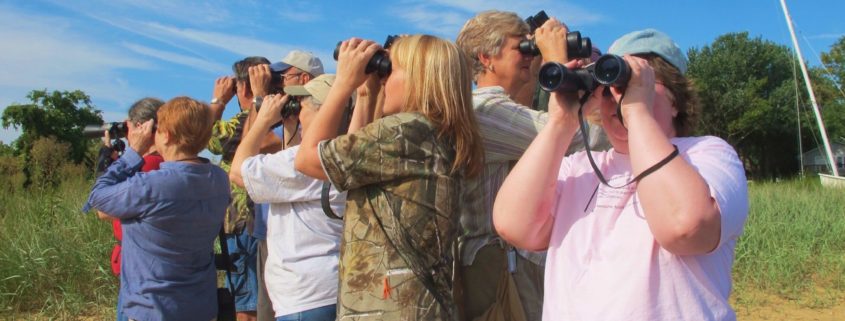
Choosing the right binoculars is critical for successful birding. Before purchasing a pair, talk to others, check for information online, and decide what qualities you want in your binoculars. Factors that you have to consider before purchasing binoculars include:
- Type
- Magnification
- Weight
- Cost
Types:
There are 2 basic types of binoculars:
- Porro prism binoculars are the traditional shaped binoculars that you see. The light-gathering objective lenses are set wider apart than the eyepiece lenses.
- Roof prism binoculars are more expensive but lighter binoculars. They have both the eyepiece lenses and light-gathering lenses in line with each other.
Magnification:
There are 2 numbers (separated by an “X”) associated with each pair of binoculars (eg. 7 x 35). The first number is the power or magnification of the lenses. The second number tells you the size of the objective lens (the light-gathering lens). Most birders use binoculars with a magnification from 7x to 10x. While larger magnification might seem better, the magnification not only magnifies the image but your hand shake as well. 7X or 8X binoculars are thus the most widely chosen.
The size of the objective lens determines the amount of light gathered by by your binoculars. The higher the number, the better your binoculars will work in lower light. However, larger objective lenses means heavier binoculars, and that makes a huge difference if you spend a lot of time in the field carrying them around.
This is where the second number comes in. The second number divided by the first number determines the size (in millimeters) of the image the binoculars will deliver to your eye. This is called the exit pupil length. Any number between 4 and 6 is considered very good.
Weight:
Most individuals select full-sized binoculars (7 x 35 up to 8 x 42). These deliver the best light gathering abilities without becoming too heavy. You can buy compact binoculars (eg. 7 x 20, 8 x 25). These are light, but you lose a lot of their light gathering abilities. They’re fine in bright light, but lose the ability to capture color as light dims or in shadows.
Cost:
This is obviously the key issue for a beginning birder. You can spend $2,000 on a pair of binoculars if you want, and you will get a wonderful piece of equipment, but buy what you need. Most birders pay more than $200 for a pair of binoculars, but this is a hefty sum unless you know that birding is your passion. At the same time beware of a cheap pair that you can buy in a local store. Plastic objectives are useless, and cheap glass is almost as bad. As binocular price goes up, so does the quality of the lenses and the workmanship. There are some good binoculars at around $100 that are worth considering. Getting binoculars that are waterproof adds to the cost.
In the backpacks that YMOS gives out, we include Eagle Optics Triumph 8 x 42 binoculars, and these make a good beginning pair for a novice birder.
Once you own a pair of binoculars, check out our How to Use Binoculars page.
